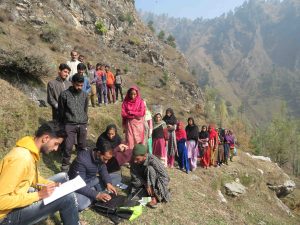WTI initiates Hangul Recovery Project by convergence of the local people
18th November 2021, Haknar: Wildlife Trust of India launched its Hangul Recovery Project with community convergence to bring back this Critically Endangered ungulate to a sustainable population in its range state, Kashmir.
Endemic to Jammu and Kashmir, the Hangul or Kashmir Stag (Cervus hanglu hanglu) was once distributed more or less continuously along the north bank of Jhelum, in the mountains of Kashmir (Gee 1965; Schaller 1969), along the Zanskar mountain range in the North-West Himalayan Biogeographic Zone (2A) (Rodgers and Panwar 1988) of India. However, over the past couple of decades, their numbers have considerably declined in both range and population. WTI’s Hangul Recovery Project, in collaboration with the J & K Department of Wildlife Protection and supported by Serenity Trust, aims to stabilize and support a sustainable population of the ungulate, especially outside the Dachigam National Park.
Decline in Hangul Population
Poaching, habitat fragmentation, anthropogenic and developmental pressure from expanding human population and livestock grazing caused a sharp decrease in the hangul population. The current viable population is restricted to Dachigam National Park and its adjoining landscape, while some of the historical home ranges of the antelope still hold small numbers of the animal. Although, the Hangul is the State Animal of Jammu and Kashmir, the species has disappeared from most sites.

Hanguls at salt lick in Dachigam NP, Photo by: Syed Suhail
Establishing functional hangul corridors and sites and protecting the existing tiny sub-populations on priority are immediate steps towards the species conservation. Consequently, WTI’s hangul corridor securement project was initiated in Sindh Valley between Dachigam National Park and Wangat Conservation Reserve, from Kangan to Sonmarg, on either side of the national highway.
Community Convergence
Conservation has never been successful without a buy-in from local community. Both as primary stakeholders and also as ones with direct interaction with endemic wildlife, it is important to have them become a part of the efforts.
However, building trust and getting support from locals takes time and needs the right initiatives at the right time. The changes required for the corridor to be secured will vastly affect the current lifestyle of people in the landscape. While they understand the need for securing the landscape, it was also necessary to incentivise them for the new adjustments. WTI had a few interactive sessions with the people to understand their issues first-hand and these consultative meetings helped us converge the necessary government schemes, such as Pradhan Mantri Awas Yojana (PMAY), Ujjwala 2.0 scheme, Ayushman Bharat and National data base of unrecognised workers (NDUC) e-SHRAM card through e-shram portal at CSC(common service centre).

Convergence of local communities at Lachipora Gawaas village in Lachipora WLS under Ayushman Baharat and eSHRAM labour card, Photo by: Sameer Kazir/WTI
At the same time, WTI initiated “hangul watcher initiative” where local teams were formed in consultation with the village heads. Three Hangul watcher groups have currently been mobilized in Gund Haknar, Surfraw Haknar and Hayen villages. They will play a crucial role in monitoring and protecting the animal around the corridors. These groups, being a part of the local structures, will be crucial to incorporate the conservation goals into the local scheme of things.
The Hangul Recovery Project, supported by the J & K Department of Wildlife Protection and Serenity Trust, encompasses identifying and protecting new areas with hangul population while re-establishing functionality of important wildlife corridors, not limited to the hangul. We hope that the state animal of Jammu and Kashmir finds a safe haven in a landscape that it has forever been its home.









